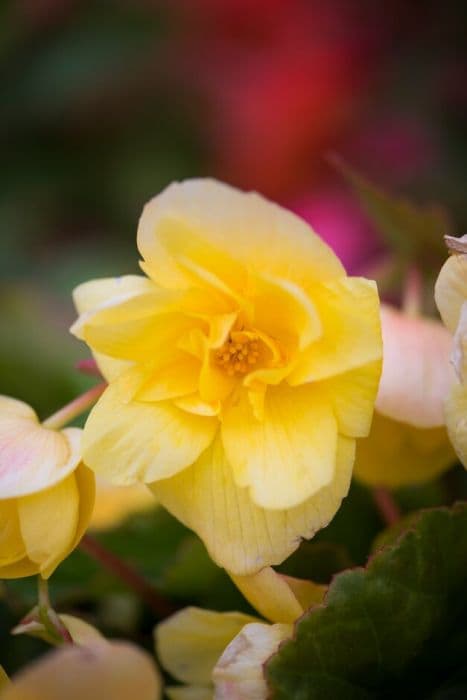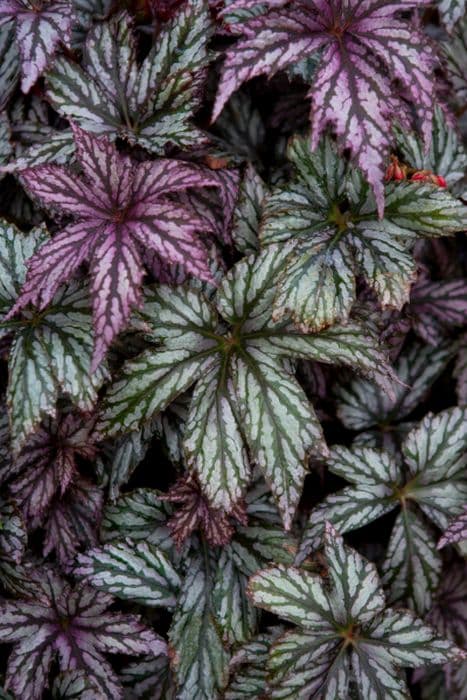Begonia 'Rose With Bronze Leaf' Begonia × benariensi (Big series Group) 'Rose With Bronze Leaf'

ABOUT
'Rose With Bronze Leaf' is a vigorous, tender evergreen perennial which is often grown as an annual. Fleshy stems produce waxy, heart-shaped leaves which can be dark bronze to green in colour. Loose clusters of single, dark pink flowers are produced during the summer months.
About this plant
 Names
NamesFamily
Begoniaceae
Synonyms
Big Begonia, Big Rose with Bronze Leaf Begonia, Bronze Leaf Begonia, Big Series Begonia
Common names
Begonia × benariensis 'Rose With Bronze Leaf'
 Characteristics
CharacteristicsLife cycle
Annuals
Foliage type
Evergreen
Color of leaves
Bronze
Flower color
Rose
Height
1-2 feet (30-60 cm)
Spread
1-2 feet (30-60 cm)
Plant type
Herb
Hardiness zones
10
Native area
South America
Benefits
 General Benefits
General Benefits- Visual Appeal: The begonia offers vibrant rose-colored flowers and bronze-colored leaves, adding a striking contrast to garden settings or as a decorative indoor plant.
- Low Maintenance: This variety of begonia is easy to care for, requiring minimal upkeep, making it ideal for both novice and experienced gardeners.
- Versatility: Suitable for use in flower beds, borders, containers, and hanging baskets, allowing for flexibility in garden design and indoor decoration.
- Drought Tolerance: Once established, it exhibits a degree of drought tolerance, reducing the need for frequent watering.
- Continuous Blooming: The plant blooms continuously from spring to frost, providing long-lasting color and interest throughout the seasons.
- Deer Resistance: Typically resistant to deer, making it a good choice for gardens in areas where deer are a common problem.
- Heat Tolerance: It can withstand high temperatures, making it suitable for warm climates and hot summer gardens.
- Soil Adaptability: Can adapt to a range of soil types, though it prefers well-draining soil, making it relatively easy to incorporate into diverse garden conditions.
 Medical Properties
Medical PropertiesThis plant is not used for medical purposes.
 Air-purifying Qualities
Air-purifying QualitiesThis plant is not specifically known for air purifying qualities.
 Other Uses
Other Uses- Photography Subjects: The striking contrast between the rose-colored flowers and bronze leaves makes the Begonia an excellent subject for botanical photography and macro photography workshops.
- Educational Tool: Horticulture educators can use the Begonia in courses about hybridization and plant breeding due to its cultivated origin.
- Artistic Inspiration: Artists may find the combination of colors and textures in the Begonia's foliage and flowers to be inspiring for paintings, illustrations, and textile designs.
- Living Mulch: When planted densely, Begonia can act as a living mulch, helping to retain soil moisture and suppress weed growth.
- Culinary Decoration: While not edible, Begonia flowers can be used to elegantly decorate cakes and desserts for a short time if they are pesticide-free.
- Craft Projects: The vibrant leaves and flowers of the Begonia can be used in pressed flower crafts and botanical paper-making.
- Seasonal Displays: Begonias can be used to create seasonal displays in public spaces, theme parks or events with their striking foliage as a backdrop for fall-themed decorations.
- Models for Scientific Illustration: Begonias are often featured in botanical illustration where precision and plant anatomy are studied and represented in fine detail.
- Color Theme Gardens: Use the rich bronze foliage as a basis for designing a color-themed garden area, potentially coordinating with other plants that have similar or complementary hues.
- Theater and Film: Begonias can be used on set as part of stage design or in film to help create a specific visual setting or mood due to their bold appearance.
Interesting Facts
 Feng Shui
Feng ShuiThe Begonia is not used in Feng Shui practice.
 Zodiac Sign Compitability
Zodiac Sign CompitabilityThe Begonia is not used in astrology practice.
 Plant Symbolism
Plant Symbolism- Caution: Begonias often symbolize caution and a reminder to stay alert to potential dangers or missteps.
- Uniqueness: The unique aspect of Begonia 'Big Rose with Bronze Leaf', with its striking color contrast, can represent individuality and distinctive personality traits.
- Harmony: With its balanced and symmetrical growth, begonias can symbolize harmony and peaceful coexistence.
- Gratitude: Begonias have been associated with gratitude and appreciation, making them appropriate gifts to express thankfulness.
- Fertility: In certain cultural contexts, begonias can represent fertility and plenitude due to their prolific blooming nature.
 Water
WaterThe Big Begonia 'Rose With Bronze Leaf' should be watered thoroughly when the top inch of soil feels dry to the touch. During active growth in spring and summer, this may require watering approximately every 7 to 10 days, but always check soil moisture before adding water. It's best to use a watering can to gently water the plant at the base, avoiding splashing water on the leaves to prevent disease. Provide enough water so that it runs out of the drainage holes at the bottom of the pot. This may equate to around 16-32 ounces for a standard indoor pot, depending on size; adjust as needed for your specific conditions.
 Light
LightBig Begonia 'Rose With Bronze Leaf' thrives in bright, indirect sunlight. It is best to place it near an east or west-facing window where it will receive moderate light but be protected from the harsh direct sun of midday, which can scorch its leaves.
 Temperature
TemperatureBig Begonia 'Rose With Bronze Leaf' prefers temperatures between 65°F and 75°F during the day and no cooler than 60°F at night. It should be protected from temperatures below 50°F, as cold temperatures can damage the plant. The ideal temperature range ensures vigorous growth and blooms.
 Pruning
PruningBig Begonia 'Rose With Bronze Leaf' benefits from pruning to remove dead or wilted flowers and leaves, which encourages new growth and bloom production. Pruning is best done in late winter or early spring before new growth begins. Snip the stems just above a leaf node using clean, sharp shears.
 Cleaning
CleaningAs needed
 Soil
SoilBegonias such as the Big Begonia 'Rose With Bronze Leaf' thrive best in a light, well-draining potting mix that includes peat moss, perlite, and vermiculite. The ideal pH for this plant's soil is slightly acidic to neutral, ranging from 5.5 to 6.5.
 Repotting
RepottingBig Begonias generally require repotting every one to two years or when the plant outgrows its current pot. Freshen up the soil mix to ensure continued growth and health.
 Humidity & Misting
Humidity & MistingBig Begonias prefer high humidity levels, ideally between 50% to 60%. They benefit from a humid environment but should not be subjected to wet foliage.
 Suitable locations
Suitable locationsIndoor
Place near bright, indirect light and maintain high humidity for Big Begonia.
Outdoor
Choose a shaded spot with morning sun and shelter from harsh weather for Big Begonia.
Hardiness zone
10-11 USDA
 Life cycle
Life cycleThe Big Begonia, Begonia × benariensis 'Rose With Bronze Leaf', begins its life cycle with seed germination, which typically occurs in warm, moist soil within a couple of weeks after planting. After germination, the seedling stage is characterized by the growth of a pair of initial leaves and the establishment of a rudimentary root system. As the plant enters the vegetative growth stage, it develops a bushy structure and bronze-tinted leaves, with an increasing number of leaf nodes. Flowering commences once the plant matures, showcasing clusters of rose-colored flowers that attract pollinators and may last several weeks to months depending on environmental conditions. Post-pollination, if conditions are conducive, the flowers may produce seeds, completing the sexual reproduction cycle. The plant will continue to grow and may require pruning to maintain shape until senescence sets in, leading to a gradual decline in vigor and potentially the end of the plant's life unless propagation through cuttings has occurred.
 Propogation
PropogationPropogation time
Spring-Summer
The Big Begonia, known for its lush rose-colored flowers and striking bronze leaves, is typically propagated through stem cuttings, which is the most popular method due to its ease and effectiveness. To propagate by stem cuttings, one should select a healthy stem about 4 to 6 inches long (which is approximately 10 to 15 centimeters) and remove the lower leaves. The cut end of the stem can then be dipped in rooting hormone powder to encourage root growth. Next, the stem is planted in a well-draining soil mix, making sure at least one node is buried where leaves were removed, as this is where roots will develop. The soil should be kept moist but not waterlogged, and the cutting should be placed in bright, indirect light. Roots usually begin to form within a few weeks, after which the new begonia plant can be transplanted into its final container or garden space.




![Begonia [Devotion]](/_next/image?url=https%3A%2F%2Fplants-admin.emdemapps.com%2Fimages%2Fplants%2F%2Fimages%2F604b58183573b.png&w=640&q=75)




